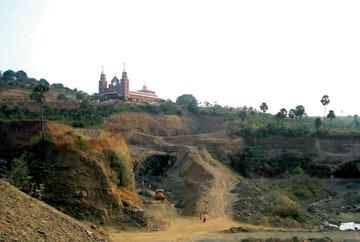|
NEWS NOTES
Did volcanic eruptions kill the dinosaurs?
 Photo courtesy of Gerta Keller |
| Tiny marine fossils known to have evolved just after the mass extinctions at the end of the Cretaceous period were found in lava beds at Rajahmundry Quarry, about 1,000 kilometers from the center of India’s Deccan Traps. |
Most geologists think that a meteor impact with Earth was ultimately responsible for the demise of the dinosaurs 65 million years ago, but a small group has contested this view. Now, tiny microfossils found in a series of giant lava flows in India may bolster their position, they say, by showing that the massive volcanic eruptions coincided with the mass extinctions — suggesting that those ancient volcanoes may have really been to blame.
Geologist Gerta Keller of Princeton University in New Jersey remains unconvinced of the Chicxulub impact hypothesis of extinction. She has focused much of her research on whether the impact on Mexico’s Yucatan Peninsula and the extinctions, which marked the end of the Cretaceous and the start of the Tertiary periods (the K/T boundary), actually coincided. In 2006, Keller sparked another round of debates over the demise of the dinosaurs, presenting sediment core data at a scientific meeting that she said showed that the Chicxulub impact had occurred 300,000 years before the K/T extinction event, and therefore couldn’t have caused it. Although a layer of iridium-rich sediment — a telltale sign of meteoric impact — does occur at the K/T boundary, Keller has stated that another meteoric impact must have occurred at that time, which may have ultimately been responsible for the extinctions.
Another leading contender has been India’s Deccan Traps, a succession of giant lava flows more than 2,000 meters thick that spread across a large chunk of the western part of the country near the end of the Cretaceous period, and are between 60 million and 68 million years old. Some researchers have suggested that the eruptions, which occurred in several huge pulses over 3.5 million years, expelled so much sulfur dioxide gas and carbon dioxide gas into the atmosphere that they had a catastrophic effect on Earth’s climate, and ultimately on all life. One drawback to this hypothesis, however, has been the uncertainty in determining when exactly the lava flows occurred.
In October 2007, at the Geological Society of America’s (GSA) annual meeting in Denver, Colo., Keller presented new data that she said bolster the Deccan Traps hypothesis by linking the volcanic eruptions more closely in time to the mass extinctions. The new dates come from a nine-meter-thick layer of sediments trapped between two outcrops of the large lava flows near the Bay of Bengal. The once-shallow marine sediments contain microfossils — specifically, planktonic foraminifera — that precisely date the end of the largest eruptive phase to the K/T boundary, she says. Furthermore, she says, the low diversity and deformation of the microfossils in the layer imply high-stress conditions at that time, while the absence of an iridium layer coinciding with the K/T boundary in the sediments could be due to a gap in the record of 100,000 years or so.
Keller says she plans to continue searching for evidence of the K/T boundary within the Deccan Traps for more data to further support her hypothesis. Meanwhile, she is also continuing to look for evidence on the other side of the world, in sediment cores from Mexico, Texas and Belize that she says will counter the Chicxulub impact hypothesis. Both the Deccan Traps and an additional meteoric impact may bear the ultimate responsibility for the dinosaurs’ deaths, she says. “Right now, I think we have to look at a scenario that includes multiple events.”
Critics of Keller’s ideas remain unimpressed by the new data from the GSA meeting. Jan Smit of the Vrije Universiteit in Amsterdam says Keller’s study contains “nothing new, and [is] all very speculative.” Philippe Claeys of the Vrije Universiteit in Brussels, Belgium, adds that Keller’s data “have completely failed to convince me that the Deccan had anything to do with the K/T extinction.” One large point of contention, Claeys says, is the question of whether the volcanoes could have ejected enough sulfur dioxide and carbon dioxide to cause such mass extinctions. Additionally, other researchers have identified the K/T boundary within a layer of sediment deposited between two Deccan lava flows, which also contained abundant organisms, he says. “[The organisms] did not seem to have suffered too much from these so-called catastrophic eruptions.”

 Subscribe
Subscribe


